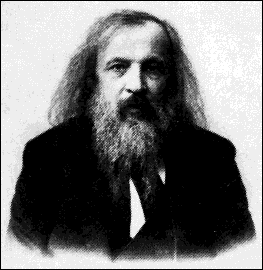|
|
NSC111: Physics/Earth/Space
|

II. Mendeleev and the Periodic TableAbout the middle of the 18th Century, chemists became conscious of the Law of Definite Proportions: In chemical reactions, substances always combine in fixed proportions by weight. These proportions do not vary in different instances of the same process, nor in the same compound made by different methods. By the turn of the 19th Century, chemists had begun to explain this in terms of atoms, which -- being themselves integral, indivisible objects -- could combine only in whole-number ratios. Actually, in some bulk materials atoms do not combine in simple whole-number ratios; such compounds are called Berthollides. This led directly to the idea, and the actual measurement, of atomic weights. However, it should be remembered that until the turn of the 20th Century, many if not most chemists did not believe in atoms as anything other than a convenient fiction. They held a strongly empiricist view of science, in which only that which could be directly observed by the five senses was held to be real. Theory was held to be a means of organizing data, not a description of reality. Therefore, atomic weights were thought to be unreal but convenient means of predicting what would show up on the scale under chemical analysis. As chemists discovered more elements and their atomic weights, it became clear that many properties of the elements, such as the number of oxygen atoms required to make their oxides, repeated in a periodic fashion when elements were listed in order of their atomic weights. This came to a head around 1865-70, when several attempts at organizing the elements in this way had already been published. In 1867, Dmitri Mendeleev was teaching what we now call "General Chemistry" at the University of St. Petersburg. Since he didn't like any of the available textbooks, he decided to write one of his own. In the process, he made notecards for each of the elements, with several properties listed on each of them. When he arranged them in order of atomic weight, he found that the elements lined up naturally into groups and families with similar properties. Up to now, he had done nothing that hadn't been done before. But he now broke new ground by going out on a limb (to mix metaphors):
Mendeleev first presented his periodic system to the Russian Chemical Society on March 6, 1869, and published it in Zeitschrift für Chemie 12, 405-6 (1869); final publication was in his general chemistry text, Principles of Chemistry (1871). He is remembered as the creator of the Periodic Table not only because he was first but because his was the best system; because he included all the known elements, not just some of them; because he trusted that system enough to leave gaps which were mostly filled in accordance with his predictions; and because the rival claimant, Lothar Meyer, published his papers on a similar, complete system a year later than Mendeleev's. Lothar Meyer's first publication on periodicity was his 1864 textbook Modern Theories of Chemistry, but Meyer's 1864 version of the system was incomplete in that it considered only 28 of the 80+ known elements. Meyer's final system was published as "The Nature of the Chemical Elements as a Function of Their Atomic Weights," Justus Liebigs Annalen der Chemie, Supplementband 7 (1870), 354--364.For more on Mendeleev's work and its consequences, see the following web sites:
|
|
Copyright © 2001 by Daniel J. Berger. This work may be copied without limit if its use is to be for non-profit educational purposes. Such copies may be by any method, present or future. The author requests only that this statement accompany all such copies. All rights to publication for profit are retained by the author. |